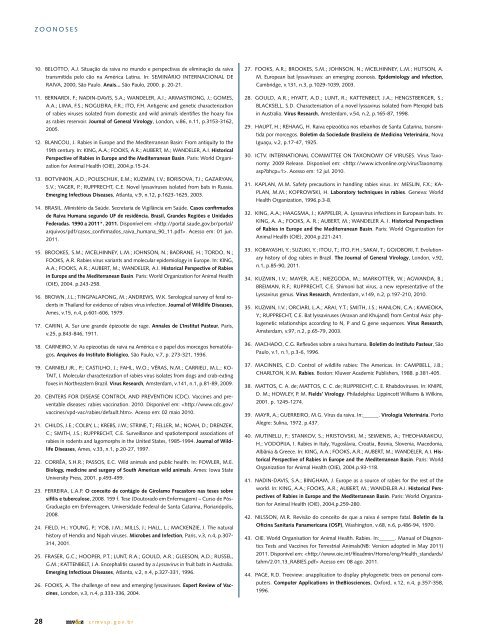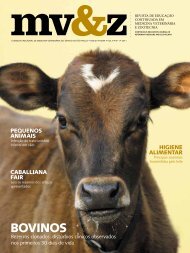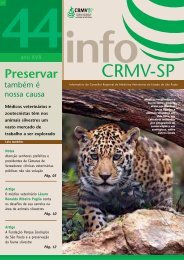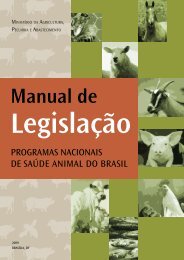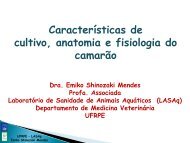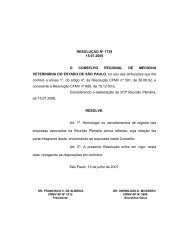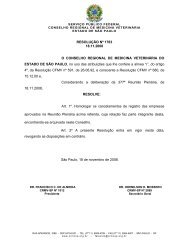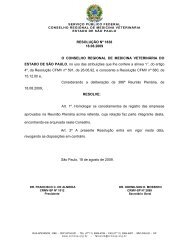Create successful ePaper yourself
Turn your PDF publications into a flip-book with our unique Google optimized e-Paper software.
z o o n o s e s10. BELOTTO, A.J. Situação da raiva no mundo e perspectivas de eliminação da raivatransmitida pelo cão na América Latina. In: SEMINÁRIO INTERNACIONAL DERAIVA, 2000, São Paulo. Anais... São Paulo, 2000. p. 20-21.11. BERNARDI, F.; NADIN-DAVIS, S.A.; WANDELER, A.I.; ARMASTRONG, J.; GOMES,A.A.; LIMA, F.S.; NOGUEIRA, F.R.; ITO, F.H. Antigenic and genetic characterizationof rabies viruses isolated from domestic and wild animals identifies the hoary foxas rabies reservoir. Journal of General Virology, London, v.86, n.11, p.3153-3162,2005.12. BLANCOU, J. Rabies in Europe and the Mediterranean Basin: From antiquity to the19th century. In: KING, A.A.; FOOKS, A.R.; AUBERT, M.; WANDELER, A.I. HistoricalPerspective of Rabies in Europe and the Mediterranean Basin. Paris: World Organizationfor Animal Health (OIE), 2004.p.15-24.13. BOTVINKIN, A.D.; POLESCHUK, E.M.; KUZMIN, I.V.; BORISOVA, T.I.; GAZARYAN,S.V.; YAGER, P.; RUPPRECHT, C.E. Novel lyssaviruses isolated from bats in Russia.Emerging Infectious Diseases, Atlanta, v.9, n.12, p.1623-1625, 2003.14. BRASIL. Ministério da Saúde. Secretaria de Vigilância em Saúde. Casos confirmadosde Raiva Humana segundo UF de residência. Brasil, Grandes Regiões e UnidadesFederadas. 1990 a 2011*. 2011. Disponível em: . Acesso em: 01 jun.2011.15. BROOKES, S.M.; MCELHINNEY, L.M.; JOHNSON, N.; BADRANE, H.; TORDO, N.;FOOKS, A.R. Rabies virus variants and molecular epidemiology in Europe. In: KING,A.A.; FOOKS, A.R.; AUBERT, M.; WANDELER, A.I. Historical Perspective of Rabiesin Europe and the Mediterranean Basin. Paris: World Organization for Animal Health(OIE), 2004. p.243-258.16. BROWN, J.L.; TINGPALAPONG, M.; ANDREWS, W.K. Serological survey of feral rodentsin Thailand for evidence of rabies virus infection. Journal of Wildlife Diseases,Ames, v.15, n.4, p.601-606, 1979.17. CARINI, A. Sur une grande épizootie de rage. Annales de L’Institut Pasteur, Paris,v.25, p.843-846, 1911.18. CARNEIRO, V. As epizootias de raiva na América e o papel dos morcegos hematófagos.Arquivos do Instituto Biológico, São Paulo, v.7, p. 273-321, 1936.19. CARNIELI JR., P.; CASTILHO, J.; FAHL, W.O.; VÉRAS, N.M.; CARRIELI, M.L.; KO-TAIT, I. Molecular characterization of rabies virus isolates from dogs and crab-eatingfoxes in Northeastern Brazil. Virus Research, Amsterdam, v.141, n.1, p.81-89, 2009.20. CENTERS FOR DISEASE CONTROL AND PREVENTION (CDC). Vaccines and preventablediseases: rabies vaccination. 2010. Disponível em: . Acesso em: 02 maio 2010.21. CHILDS, J.E.; COLBY, L.; KREBS, J.W.; STRINE, T.; FELLER, M.; NOAH, D.; DRENZEK,C.; SMITH, J.S.; RUPPRECHT, C.E. Surveillance and spatiotemporal associations ofrabies in rodents and lagomorphs in the United States, 1985-1994. Journal of WildlifeDiseases, Ames, v.33, n.1, p.20-27, 1997.22. CORRÊA, S.H.R.; PASSOS, E.C. Wild animals and public health. In: FOWLER, M.E.Biology, medicine and surgery of South American wild animals. Ames: Iowa StateUniversity Press, 2001. p.493-499.23. FERREIRA, L.A.P. O conceito de contágio de Girolamo Fracastoro nas teses sobresífilis e tuberculose, 2008. 159 f. Tese (Doutorado em Enfermagem) – Curso de Pós-Graduação em Enfermagem, Universidade Federal de Santa Catarina, Florianópolis,2008.24. FIELD, H.; YOUNG, P.; YOB, J.M.; MILLS, J.; HALL, L.; MACKENZIE, J. The naturalhistory of Hendra and Nipah viruses. Microbes and Infection, Paris, v.3, n.4, p.307-314, 2001.25. FRASER, G.C.; HOOPER, P.T.; LUNT, R.A.; GOULD, A.R.; GLEESON, A.D.; RUSSEL,G.M.; KATTENBELT, J.A. Encephalitis caused by a Lyssavirus in fruit bats in Australia.Emerging Infectious Diseases, Atlanta, v.2, n.4, p.327-331, 1996.26. FOOKS, A. The challenge of new and emerging lyssaviruses. Expert Review of Vaccines,London, v.3, n.4, p.333-336, 2004.27. FOOKS, A.R.; BROOKES, S.M.; JOHNSON, N.; MCELHINNEY, L.M.; HUTSON, A.M. European bat lyssaviruses: an emerging zoonosis. Epidemiology and infection,Cambridge, v.131, n.3, p.1029-1039, 2003.28. GOULD, A.R.; HYATT, A.D.; LUNT, R.; KATTENBELT, J.A.; HENGSTBERGER, S.;BLACKSELL, S.D. Characterisation of a novel lyssavirus isolated from Pteropid batsin Australia. Virus Research, Amsterdam, v.54, n.2, p.165-87, 1998.29. HAUPT, H.; REHAAG, H. Raiva epizoótica nos rebanhos de Santa Catarina, transmitidapor morcegos. Boletim da Sociedade Brasileira de Medicina Veterinária, NovaIguaçu, v.2, p.17-47, 1925.30. ICTV. INTERNATIONAL COMMITTEE ON TAXONOMY OF VIRUSES. Virus Taxonomy:2009 Release. Disponível em: . Acesso em: 12 jul. 2010.31. KAPLAN, M.M. Safety precautions in handling rabies virus. In: MESLIN, F.X.; KA-PLAN, M.M.; KOPROWSKI, H. Laboratory techniques in rabies. Geneva: WorldHealth Organization, 1996.p.3-8.32. KING, A.A.; HAAGSMA, J.; KAPPELER, A. Lyssavirus infections in European bats. In:KING, A. A.; FOOKS, A. R.; AUBERT, M.; WANDELER A. I. Historical Perspectivesof Rabies in Europe and the Mediterranean Basin. Paris: World Organization forAnimal Health (OIE), 2004.p.221-241.33. KOBAYASHI, Y.; SUZUKI, Y.; ITOU, T.; ITO, F.H.; SAKAI, T.; GOJOBORI, T. Evolutionaryhistory of dog rabies in Brazil. The Journal of General Virology, London, v.92,n.1, p.85-90, 2011.34. KUZMIN, I.V.; MAYER, A.E.; NIEZGODA, M.; MARKOTTER, W.; AGWANDA, B.;BREIMAN, R.F.; RUPPRECHT, C.E. Shimoni bat virus, a new representative of theLyssavirus genus. Virus Research, Amsterdam, v.149, n.2, p.197-210, 2010.35. KUZMIN, I.V.; ORCIARI, L.A.; ARAI, Y.T.; SMITH, J.S.; HANLON, C.A.; KAMEOKA,Y.; RUPPRECHT, C.E. Bat lyssaviruses (Aravan and Khujand) from Central Asia: phylogeneticrelationships according to N, P and G gene sequences. Virus Research,Amsterdam, v.97, n.2, p.65-79, 2003.36. MACHADO, C.G. Reflexões sobre a raiva humana. Boletim do Instituto Pasteur, SãoPaulo, v.1, n.1, p.3-6, 1996.37. MACINNES, C.D. Control of wildlife rabies: The Americas. In: CAMPBELL, J.B.;CHARLTON, K.M. Rabies. Boston: Kluwer Academic Publishers, 1988. p.381-405.38. MATTOS, C. A. de; MATTOS, C. C. de; RUPPRECHT, C. E. Rhabdoviruses. In: KNIPE,D. M.; HOWLEY, P. M. Fields’ Virology. Philadelphia: Lippincott Williams & Wilkins,2001. p. 1245-1274.39. MAYR, A.; GUERREIRO, M.G. Vírus da raiva. In:______. Virologia Veterinária. PortoAlegre: Sulina, 1972. p.437.40. MUTINELLI, F.; STANKOV, S.; HRISTOVSKI, M.; SEIMENIS, A.; THEOHARAKOU,H.; VODOPIJA, I. Rabies in Italy, Yugoslávia, Croatia, Bosnia, Slovenia, Macedonia,Albânia & Greece. In: KING, A.A.; FOOKS, A.R.; AUBERT, M.; WANDELER, A.I. HistoricalPerspective of Rabies in Europe and the Mediterranean Basin. Paris: WorldOrganization for Animal Health (OIE), 2004.p.93-118.41. NADIN-DAVIS, S.A.; BINGHAM, J. Europe as a source of rabies for the rest of theworld. In: KING, A.A.; FOOKS, A.R.; AUBERT, M.; WANDELER A.I. Historical Perspectivesof Rabies in Europe and the Mediterranean Basin. Paris: World Organizationfor Animal Health (OIE), 2004.p.259-280.42. NILSSON, M.R. Revisão do conceito de que a raiva é sempre fatal. Boletín de laOficina Sanitaria Panamericana (OSP), Washington, v.68, n.6, p.486-94, 1970.43. OIE. World Organisation for Animal Health. Rabies. In:______. Manual of DiagnosticsTests and Vaccines for Terrestrial Animals(NB: Version adopted in May 2011)2011. Disponível em: Acesso em: 08 ago. 2011.44. PAGE, R.D. Treeview: anapplication to display phylogenetic trees on personal computers.Computer Applications in theBiosciences, Oxford, v.12, n.4, p.357-358,1996.28 mv&z c r m v s p . g o v . b r


